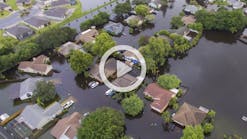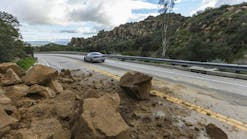California’s high snowpack brings drought relief, flood risk
The California Department of Water Resources (DWR) announced that the state’s snowpack is at its highest recorded level, bringing both drought relief and flood concerns.
DWR conducted its fourth snow survey of the season at Phillips Station. The manual survey recorded 126.5 inches of snow depth and a snow water equivalent of 54 inches, which is 221 percent of average for this location on April 3.
The snow water equivalent measures the amount of water contained in the snowpack and is a key component of DWR’s water supply forecast. DWR’s electronic readings from 130 snow sensors placed throughout the state indicate the statewide snowpack’s snow water equivalent is 61.1 inches, or 237 percent of average for this date.
“This year’s severe storms and flooding is the latest example that California’s climate is becoming more extreme,” said DWR Director Karla Nemeth. “After the driest three years on record and devastating drought impacts to communities across the state, DWR has rapidly shifted to flood response and forecasting for the upcoming snowmelt. We have provided flood assistance to many communities who just a few months ago were facing severe drought impacts.”
DWR says that this year is showing how the state’s flood infrastructure will continue to face climate-driven challenges for moving and storing as much of these flood water as possible.
This year’s April 1 result from the statewide snow sensor network is higher than any other reading since the snow sensor network was established in the mid-1980s. Before the network was established, the 1983 April 1 statewide summary from manual snow course measurements was 227 percent of average. The 1952 April 1 statewide summary for snow course measurements was 237 percent of average.
“This year’s result will go down as one of the largest snowpack years on record in California,” said Sean de Guzman, manager of DWR’s Snow Surveys and Water Supply Forecasting Unit. “While 1952’s snow course measurements showed a similar result, there were fewer snow courses at that time, making it difficult to compare to today’s results. Because additional snow courses were added over the years, it is difficult to compare results accurately across the decades with precision, but this year’s snowpack is definitely one of the biggest the state has seen since the 1950s.”
For California’s snow course measurements, only 1952, 1969 and 1983 recorded statewide results above 200 percent of the April 1 average. While above average across the state this year, snowpack varies considerably by region. The Southern Sierra snowpack is currently 300 percent of its April 1 average and the Central Sierra is at 237 percent of its April 1 average. However, the critical Northern Sierra, where the state’s largest surface water reservoirs are located, is at 192 percent of its April 1 average.
Flood risks
The size and distribution of this year’s snowpack is also posing severe flood risk to areas of the state, especially the Southern San Joaquin Valley.
DWR’s State-Federal Flood Operations Center (FOC) is supporting emergency response in the Tulare Lake Basin and Lower San Joaquin River by providing flood fight specialists to support ongoing flood response activities and by providing longer-term advanced planning activities.
The FOC and DWR’s Snow Surveys and Water Supply Forecasting Unit are helping local agencies plan for the spring snowmelt season by providing hydraulic and hydrologic modeling and snowmelt forecasts specific to the Tulare Lake Basin that are informed by DWR’s snowmelt forecasting tools, including Airborne Snow Observatory (ASO) surveys.
Storms this year have caused impacts across the state including flooding in the community of Pajaro and communities in Sacramento, Tulare, and Merced counties. The FOC has provided over 1.4 million sandbags, over 1 million square feet of plastic sheeting, and over 9,000 feet of reinforcing muscle wall, across the state since January.
DWR conducts five media-oriented snow surveys at Phillips Station each winter near the first of each month, January through April and, if necessary, May. Given the size of this year’s snowpack with more snow in the forecast, DWR anticipates conducting a May snow survey at Phillips Station, tentatively scheduled for May 1.






